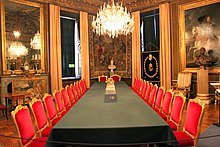King-in-Council
TheKing-in-Councilor theQueen-in-Council,depending on thegenderof the reigning monarch, is a constitutional term in a number of states. In a general sense, it refers to the monarch exercisingexecutive authority,usually in the form of approving orders, on theadviceof the country'sprivy councilorexecutive council.
In nations where the reigning monarch is represented by aviceroy,derivative terms are used instead, such asGovernor in CouncilorLieutenant Governor in Council.
Norway
[edit]In Norway, the King in Council (Norwegian:Kongen i statsråd) refers to the meetings of the King and theCouncil of State(the Cabinet), wherein matters of importance and major decisions are made. The Council meets at theRoyal Palace,normally every Friday. These meetings are chaired bythe monarchor, if he is ill or abroad, crown prince (the monarch's heir). In Norway's constitution,King in Councilrefers to the formalGovernment of Norway,whereas merelyKingmeans the appointedministrythat the law refers to may alone act with complete authority on the matter assigned in the particular law.[1]
A decision that is taken in the State Council under the sovereign's leadership is considered to be a royal decree. If the crown prince chairs, they are crown prince resolutions. When neither the monarch nor the crown prince chairs, resolutions adopted are called government resolutions.
Sweden
[edit]
In Sweden, the King in Council (Swedish:Konungen i Statsrådet), more commonly known asRoyal Majesty(Swedish:Kunglig Majestätor the short formsKungl.Maj:torK.M:t) was a concept of constitutional importance until 1974.
Royal Majestywas the commonly used term to refer to the supreme executive authority under the1809 Instrument of Government,under whichthe monarchmade all decisions of state in the presence of his Cabinet ministers. The1974 Instrument of Governmentremoved the monarch from all exercise of formal political powers, which were passed to the newly createdgovernment(Swedish:Regeringen), chaired and led in all aspects by theprime minister.The monarch continues to head the Cabinet councils (the sovereign plus the members of the government) and the Council on Foreign Affairs, recognizing new cabinets (in the Council of State).
Commonwealth realms
[edit]The King-in-Councilis the technical term ofconstitutional lawfor the exercise ofexecutive authorityin aCommonwealth realm,denoting themonarchacting by and with theadvice and consentof his or her privy council (in theUnited KingdomandCanada's federal jurisdiction) orexecutive council(in most other Commonwealth realms and theAustralian statesandCanadian provinces). In those realms and dependencies where the sovereign's powers and functions are delegated to agovernor-general,lieutenant governor,orgovernor,the termGovernor-General-in-Council,Lieutenant Governor-in-Council,orGovernor-in-Councilmay be used instead ofKing-in-Council,all of these terms describing the same technical process within constitutional law.The government of [jurisdiction]is commonly used as a synonym for any of the aforementioned terms, though the phrase may mean more than one thing in certain areas.
An order made by the King-in-Council is known as anorder-in-counciland such actions are subject tojudicial review.[n 1]Orders-in-council may be used to implementsecondary legislation,such as Britishstatutory instruments.In practice, decisions made by the King-in-Council are almost always the formal approval to decisions made by thecabinet,a subcommittee of the privy or executive council that includes the seniorministers of the Crownand often meets without the monarch or his local representative present.
Former Commonwealth realms and dependencies often retain a similar constitutional concept; for example,President-in-CouncilinIndia[3][4]orChief Executive-in-CouncilinHong Kong.[5]Similar concepts can also be found in some non-Commonwealth countries.[6]
See also
[edit]Sweden
[edit]The Commonwealth
[edit]Ireland
[edit]Notes
[edit]- ^"The source of the power to make the order-in-council was the royal prerogative. Neither Her Majesty nor the members of the Privy Council present that day (which, coincidentally, included me) considered the merits of the order. The Queen-in-Council acts upon the advice of a minister, in the present case, the Secretary of State for Foreign and Commonwealth Affairs. In reality, the order was that of the Secretary of State, although, of course, the Queen formally assented to it."[2]
References
[edit]- ^"Norges Grunnlov".Lovdata.Retrieved29 November2023.
- ^The Queen on the Application of Louis Olivier Bancoult v. The Secretary of State for Foreign and Commonwealth Affairs,CO/4093/2004,s.5 (England and Wales High Court11 May 2006).
- ^Constituent Assembly of India debates (IV:12)Archived29 October 2015 at theWayback Machine.Parliament of India
- ^Subhash C. Kashyap."The President's Powers".The Hindu.25 July 2002
- ^Adaption of Laws (Interpretive Provisions) Ordinance1998 (Hong Kong)
- ^Juliet Edeson (1998). "Powers of Presidents in Republics",Papers on Parliament No. 31,Parliament of Australia





